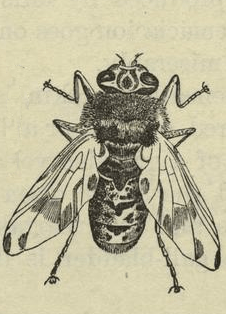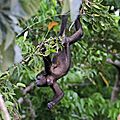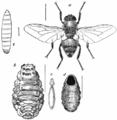Botfly facts for kids
Quick facts for kids Botfly |
|
|---|---|
 |
|
| Horse botfly (Gasterophilus intestinalis) | |
| Scientific classification |
|
| Kingdom: | Animalia |
| Phylum: | Arthropoda |
| Class: | Insecta |
| Order: | Diptera |
| Suborder: | Brachycera |
| Infraorder: | Muscomorpha |
| Section: | Schizophora |
| Subsection: | Calyptratae |
| Superfamily: | Oestroidea |
| Family: | Oestridae |
| Subfamilies | |
|
|
Botflies are a special family of flies. You might also hear them called warble flies or gadflies. What makes them unique is how their babies, called larvae, grow up. These larvae live inside other animals, usually mammals. Some larvae grow under the skin of their host, while others live inside the host's stomach or intestines. They are a type of parasite, which means they live on or in another living thing and get their food from it.
Contents
What are Botflies?
Botflies belong to a scientific family called Oestridae. They are insects, just like house flies or mosquitoes. Adult botflies are usually hairy and look a bit like bees. But it's their larvae that are really interesting! These larvae are like tiny worms or maggots.
How Botflies Live
Botflies have a fascinating life cycle. The adult female botfly lays her eggs on an animal or near it. For example, some lay eggs on grass where animals graze. Other botflies might lay eggs directly on the animal's fur.
Once the eggs hatch, the tiny larvae need to get inside a host animal. They might crawl in through the skin, or the animal might swallow them while grooming or eating.
Life Inside a Host
After getting inside, the larvae start to grow. They can live in different parts of the host's body. Some live just under the skin, forming a lump called a "warble." Others might live in the host's stomach or throat. They feed on the host's tissues or fluids.
When the larvae are fully grown, they leave the host's body. They usually drop to the ground and turn into a pupa. This is a resting stage, like a cocoon. After a while, an adult botfly emerges from the pupa, and the cycle begins again.
Botflies and Animals
Botflies can affect many different mammals. This includes animals like horses, cattle, deer, and even monkeys.
Botflies and Horses
One common type is the horse botfly. The adult female lays tiny yellow eggs on the horse's legs, shoulders, or mane. When the horse licks itself, the eggs hatch, and the larvae enter the horse's mouth. They then travel to the stomach, where they attach to the lining.
These larvae can stay in the horse's stomach for many months. When they are ready, they pass out of the horse's body and turn into pupae in the soil.
Botflies and Cattle
Cattle can be affected by ox warble flies. These flies lay eggs on the cow's legs. The larvae then burrow into the cow's skin and travel through its body. They eventually settle under the skin on the cow's back, creating a lump.
Images for kids
See also
 In Spanish: Éstridos para niños
In Spanish: Éstridos para niños





